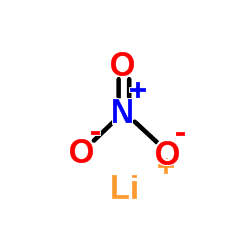Formula LiNO3 Density 2.38 g/cm³ | Molar mass 68.946 g/mol Boiling point 600 °C | |
 | ||
Related compounds Appearance White to light yellow solid | ||
Lithium nitrate is an inorganic compound with the formula LiNO3. It is the lithium salt of nitric acid (an alkali metal nitrate). It is made by reacting lithium carbonate or lithium hydroxide with nitric acid.
Contents
Uses
This deliquescent colourless salt is an oxidizing agent used in the manufacture of red-colored fireworks and flares.
Lithium Nitrate has been proposed as a medium to store heat collected from the sun for cooking. A Fresnel lens would be used to melt solid lithium nitrate, which would then function as a 'solar battery', allowing heat to be redistributed later by convection.
LiNO3 is utilized in solute-solvent interactions at decreasing temperatures (i.e. 329-290 K) which in effect, can be used to transport ions in binary solutions of molten acetamide.
Currently, lithium nitrate is being tested to see if it can be applied to concrete-pavement to withstand weathering effects.
In the lab, LiNO3 is commonly bound to a trihydrate ion in order to test bifurcated hydrogen bonds within crystal structures of molecules which can correlate to hydrogen bond strength.
Lithium nitrate is also used as a catalyst which accelerates the breakdown of nitrogen oxides, through oxidation, found in soot.
Synthesis
Lithium nitrate can be synthesized by reacting nitric acid and lithium carbonate.
Li2CO3 + 2 HNO3 → 2 LiNO3 + H2O + CO2Generally when forming LiNO3, a pH indicator is used to determine when all of the acid has been neutralized. However, this neutralization can also be recognized with the loss of carbon dioxide production. In order to rid the final product of excess water, the sample is heated.
Properties
Upon thermal decomposition, LiNO3 gives lithium oxide (Li2O), nitrogen dioxide, and oxygen:
4 LiNO3 → 2 Li2O + 4 NO2 + O2Other group I nitrates decompose differently, forming the nitrite salt and oxygen. Because of its relatively small size, the lithium cation is very polarizing, which favors the formation of the oxide.
Lithium nitrate is also a very good oxidizing agent.
Toxicity
Lithium nitrate can be toxic to the body when ingested by targeting the central nervous system, thyroids, kidneys, and cardio-vascular system. When exposed to the skin, eyes, and mucous membranes, lithium nitrate can cause irritation to these areas.
